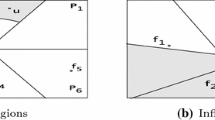Abstract
The influence zone method is used to answer reverse k nearest neighbours (RkNN) queries using a region approach without having to verify each object; this makes the answering of a RkNN query more efficient than does the conventional point-to-point approach. However, the influence zone is unable to answer the dynamic value of k efficiently as it needs to know this value in advance. In this paper, a concept is introduced whereby the influence zone is expanded to enable answering the dynamic value of k as well. Furthermore, a concept is proposed that expands the influence zone of k= 1. Experimental results indicate that the expanded influence zone is able to answer RkNN queries even when the k value is dynamic, without the need to recompute it. Furthermore, the experiments show that the use of pre-computed regions will provide a stable query time for any value of k.













Similar content being viewed by others
References
Adhinugraha KM, Taniar D, Santiago MI, Latjuba DM (2014) Reverse nearest neighbour by region on mobile devices. In Advanced Information Networking and Applications (AINA), 2014 IEEE 28th International Conference on, pp. 457–464
Adhinugraha KM, Taniar D, Indrawan M (2014) Finding reverse nearest neighbors by region. Concurr Comput: Pract Exp 26(5):1142–1156
Alamri S, Taniar D, Safar M (2014) A taxonomy for moving object queries in spatial databases. Future Generation Comp Syst 37:232–242
Alamri S (2018) Spatial data managements in indoor environments: Current trends, limitations and future challenges. Int J Web Inf Syst 14(4):402–422
Alamri S (2021) Independent map enhancement for a spatial road network: Fundamental applications and opportunities. ISPRS Int J Geo Inf 10(1):8
Aurenhammer F (1991) Voronoi diagrams – a survey of a fundamental geometric data structure. ACM Computing Surveys (CSUR) 23(3):345–405
Bryant AC, Cios KJ (2017) Rnn-dbscan: A density-based clustering algorithm using reverse nearest neighbor density estimates. IEEE Trans Knowl Data Eng
Cheema MA, Lin X, Zhang W, Zhang Y (2011) Influence zone: Efficiently processing reverse k nearest neighbors queries. In Data Engineering (ICDE), 2011 IEEE 27th International Conference on, pp. 577–588
Feng LR, Liu CM, Lai CC (2018) Probabilistic reverse nearest neighbors on uncertain data streams. In 2018 7th International Symposium on Next Generation Electronics (ISNE). IEEE, pp. 1–4
Gotoh Y (2014) A simple routing method for reverse k-nearest neighbor queries in spatial networks. In Network-Based Information Systems (NBiS), 2014 17th International Conference on. IEEE, pp. 615–620
Gu Y, Yu G, Yu X (2014) An efficient method for k nearest neighbor searching in obstructed spatial databases. J Inf Sci Eng 30:1569–1583
Hu L, Liu H, Xu B (2015) A faster algorithm of higher order voronoi diagrams. In Measuring Technology and Mechatronics Automation (ICMTMA), 2015 Seventh International Conference on. IEEE, pp. 6–9
Kang JM, Mokbel MF, Shekhar S, Xia T, Zhang D (2007) Continuous evaluation of monochromatic and bichromatic reverse nearest neighbors. In Data Engineering, 2007. ICDE 2007. IEEE 23rd International Conference on, pp. 806–815
Korn F, Muthukrishnan S (2000) Influence sets based on reverse nearest neighbor queries. In ACM Sigmod Record, vol. 29, pp. 201–212
Li B, Pan M, Wu Z (2011) Effective reverse k-nearest neighbor query based on revised r*-tree in spatial databases. In Geoinformatics, 2011 19th International Conference on. IEEE, pp. 1–5
Lin W, Tan X, Yu Y, Mao D (2009) Reverse nn search based on mr-tree for polygon dataset. In Information Science and Engineering (ICISE), 2009 1st International Conference on. IEEE, pp. 2168–2171
Okabe A, Boots B, Sugihara K, Chiu SN (2009) Spatial tessellations: concepts and applications of voronoi diagrams. Wiley Series in Probability and Statistics
Rivière S, Schmitt D (2007) Two-dimensional line space voronoi diagram. In Voronoi Diagrams in Science and Engineering, 2007. ISVD’07. 4th International Symposium on. IEEE, pp. 168–175
Safar M, Ibrahimi D, Taniar D (2009) Voronoi-based reverse nearest neighbor query processing on spatial networks. Multimed Syst 15(5):295–308
Shamos MI, Hoey D (1975) Closest-point problems. In Foundations of Computer Science, 1975., 16th Annual Symposium on. IEEE, pp. 151–162
Stanoi I, Riedewald M, Agrawal D, El Abbadi A (2001) Discovery of influence sets in frequently updated databases. VLDB 2001:99–108
Taniar D, Rahayu W (2013) A taxonomy for nearest neighbour queries in spatial databases. J Comput Syst Sci 79(7):1017–1039
Taniar D, Rahayu W (2015) A taxonomy for region queries in spatial databases in J Comput Syst Sci, vol. 81
Tran QT, Taniar D, Safar M (2009) Reverse k nearest neighbor and reverse farthest neighbor search on spatial networks. In Transactions on large-scale data-and knowledge-centered systems I. Springer, pp. 353–372
Wang S, Cheema MA, Lin X (2015) Efficiently monitoring reverse k-nearest neighbors in spatial networks. Comput J 58(1):40–56
Wang S, Bao Z, Culpepper JS, Sellis T, Cong G (2018) Reverse k nearest neighbor search over trajectories. IEEE Trans Knowl Data Eng 30(4):757–771
Yang S, Cheema MA, Lin X, Zhang Y, Zhang W (2017) Reverse k nearest neighbors queries and spatial reverse top-k queries. VLDB J 26(2):151–176
Yu H, Yang Y, Cao L, Pei C (2009) Research of reverse nearest neighbor query technology in spatial objects. In Test and Measurement, 2009. ICTM’09. International Conference on. IEEE, 2, 217–220
Zhang J, Zhu M, Papadias D, Tao Y, Lee DL (2003) Location-based spatial queries. In Proceedings of the 2003 ACM SIGMOD international conference on Management of data. ACM, pp. 443–454
Author information
Authors and Affiliations
Corresponding author
Additional information
Publisher’s Note
Springer Nature remains neutral with regard to jurisdictional claims in published maps and institutional affiliations.
Rights and permissions
About this article
Cite this article
Alvin, M., Adhinugraha, K.M., Alamri, S. et al. Influence zone expansion for reverse k nearest neighbours query. Multimed Tools Appl 83, 15253–15266 (2024). https://doi.org/10.1007/s11042-021-11275-3
Received:
Revised:
Accepted:
Published:
Issue Date:
DOI: https://doi.org/10.1007/s11042-021-11275-3




